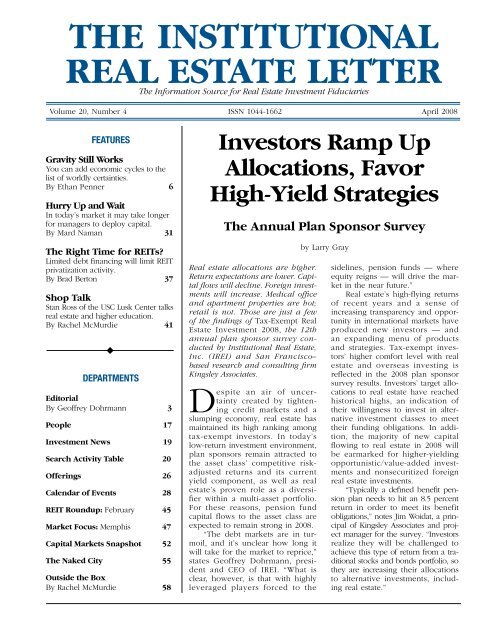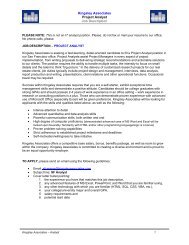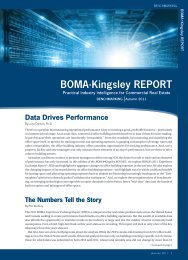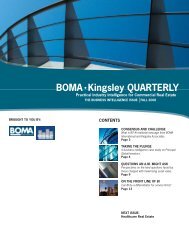THE INSTITUTIONAL REAL ESTATE LETTER - Kingsley Associates
THE INSTITUTIONAL REAL ESTATE LETTER - Kingsley Associates
THE INSTITUTIONAL REAL ESTATE LETTER - Kingsley Associates
You also want an ePaper? Increase the reach of your titles
YUMPU automatically turns print PDFs into web optimized ePapers that Google loves.
<strong>THE</strong> <strong>INSTITUTIONAL</strong><br />
<strong>REAL</strong> <strong>ESTATE</strong> <strong>LETTER</strong><br />
The Information Source for Real Estate Investment Fiduciaries<br />
Volume 20, Number 4 ISSN 1044-1662 April 2008<br />
FEATURES<br />
Gravity Still Works<br />
You can add economic cycles to the<br />
list of worldly certainties.<br />
By Ethan Penner 6<br />
Hurry Up and Wait<br />
In today’s market it may take longer<br />
for managers to deploy capital.<br />
By Mard Naman 31<br />
The Right Time for REITs?<br />
Limited debt financing will limit REIT<br />
privatization activity.<br />
By Brad Berton 37<br />
Shop Talk<br />
Stan Ross of the USC Lusk Center talks<br />
real estate and higher education.<br />
By Rachel McMurdie 41<br />
◆<br />
DEPARTMENTS<br />
Editorial<br />
By Geoffrey Dohrmann 3<br />
People 17<br />
Investment News 19<br />
Search Activity Table 20<br />
Offerings 26<br />
Calendar of Events 28<br />
REIT Roundup: February 45<br />
Market Focus: Memphis 47<br />
Capital Markets Snapshot 52<br />
The Naked City 55<br />
Outside the Box<br />
By Rachel McMurdie 58<br />
Investors Ramp Up<br />
Allocations, Favor<br />
High-Yield Strategies<br />
The Annual Plan Sponsor Survey<br />
Real estate allocations are higher.<br />
Return expectations are lower. Capital<br />
flows will decline. Foreign investments<br />
will increase. Medical office<br />
and apartment properties are hot;<br />
retail is not. Those are just a few<br />
of the findings of Tax-Exempt Real<br />
Estate Investment 2008, the 12th<br />
annual plan sponsor survey conducted<br />
by Institutional Real Estate,<br />
Inc. (IREI) and San Francisco–<br />
based research and consulting firm<br />
<strong>Kingsley</strong> <strong>Associates</strong>.<br />
Despite an air of uncertainty<br />
created by tightening<br />
credit markets and a<br />
slumping economy, real estate has<br />
maintained its high ranking among<br />
tax-exempt investors. In today’s<br />
low-return investment environment,<br />
plan sponsors remain attracted to<br />
the asset class’ competitive riskadjusted<br />
returns and its current<br />
yield component, as well as real<br />
estate’s proven role as a diversifier<br />
within a multi-asset portfolio.<br />
For these reasons, pension fund<br />
capital flows to the asset class are<br />
expected to remain strong in 2008.<br />
“The debt markets are in turmoil,<br />
and it’s unclear how long it<br />
will take for the market to reprice,”<br />
states Geoffrey Dohrmann, president<br />
and CEO of IREI. “What is<br />
clear, however, is that with highly<br />
leveraged players forced to the<br />
by Larry Gray<br />
sidelines, pension funds — where<br />
equity reigns — will drive the market<br />
in the near future.”<br />
Real estate’s high-flying returns<br />
of recent years and a sense of<br />
increasing transparency and opportunity<br />
in international markets have<br />
produced new investors — and<br />
an expanding menu of products<br />
and strategies. Tax-exempt investors’<br />
higher comfort level with real<br />
estate and overseas investing is<br />
reflected in the 2008 plan sponsor<br />
survey results. Investors’ target allocations<br />
to real estate have reached<br />
historical highs, an indication of<br />
their willingness to invest in alternative<br />
investment classes to meet<br />
their funding obligations. In addition,<br />
the majority of new capital<br />
flowing to real estate in 2008 will<br />
be earmarked for higher-yielding<br />
opportunistic/value-added investments<br />
and nonsecuritized foreign<br />
real estate investments.<br />
“Typically a defined benefit pension<br />
plan needs to hit an 8.5 percent<br />
return in order to meet its benefit<br />
obligations,” notes Jim Woidat, a principal<br />
of <strong>Kingsley</strong> <strong>Associates</strong> and project<br />
manager for the survey. “Investors<br />
realize they will be challenged to<br />
achieve this type of return from a traditional<br />
stocks and bonds portfolio, so<br />
they are increasing their allocations<br />
to alternative investments, including<br />
real estate.”
The Institutional<br />
Real Estate Letter<br />
For example, late last year<br />
the $245 billion California Public<br />
Employees’ Retirement System<br />
(CalPERS) adopted a new investment<br />
asset allocation that boosted<br />
its real estate allocation from 8 percent<br />
to 10 percent, which represents<br />
a potential increase in capital<br />
flows of $5 billion. According to<br />
Woidat, “Across our survey sample,<br />
on a same respondent basis,<br />
pension funds, foundations and<br />
endowments are raising their targets<br />
to real estate.”<br />
The survey found that taxexempt<br />
investors have raised their<br />
target real estate allocation from<br />
an average of 8.7 percent in 2007<br />
to 9.7 percent in 2008, the highest<br />
level reported in the survey’s<br />
12-year history (see “2008 Portfolio<br />
Weightings: Target vs. Actual<br />
Holdings,” below). This increase<br />
has created a larger funding gap<br />
between target and actual real<br />
estate allocations of 115 basis<br />
points, up from 40 basis points last<br />
year. It is important to note, however,<br />
that having received survey<br />
responses between October 2007<br />
and January 2008, the gap to target<br />
allocations for many investors likely<br />
has decreased due to the depletion<br />
of value within the U.S. equity<br />
markets. Assuming investors’ U.S.<br />
equities portfolios declined in line<br />
Projected Annual Capital Flows Based on Survey Results*<br />
New Capital Allocation to Real Estate ($B)<br />
2008 Portfolio Weightings: Target vs. Actual Holdings<br />
Sector<br />
$80<br />
$70<br />
$60<br />
$50<br />
$40<br />
$30<br />
$20<br />
$10<br />
$0<br />
Actual Capital Flows<br />
Expected Capital Flows<br />
37<br />
31<br />
28<br />
34<br />
44<br />
Target<br />
Mean (%)<br />
2000 2001 2002 2003 2004 2005 2006 2007 2008<br />
51<br />
Current<br />
Mean (%)<br />
59<br />
71<br />
46<br />
Difference<br />
Real Estate 9.65 8.50 –1.15<br />
U.S. Stocks 35.03 36.66 1.63<br />
Foreign Equities 18.06 18.94 0.88<br />
Fixed Income 22.70 21.92 –0.78<br />
Venture Capital / Private Equity 6.17 4.97 –1.20<br />
Money Market Funds / Cash Equivalents 0.47 1.28 0.81<br />
Hedge Funds 5.48 5.76 0.28<br />
Other 2.43 1.96 –0.47<br />
Source: Tax-Exempt Real Estate Investment 2008<br />
*Annual capital flow projections are based on respondent-provided new capital plans for<br />
each year, grossed up based on respondents’ aggregate share of the entire tax-exempt real<br />
estate universe as defined by the annual Money Market Directory.<br />
Source: Tax-Exempt Real Estate Investment 2008<br />
60<br />
with the S&P 500 Index, this gap<br />
likely closed to under 90 basis<br />
points by Feb. 29, 2008, simply due<br />
to the shrinking asset base.<br />
The survey found that<br />
tax-exempt investors<br />
have raised their target<br />
real estate allocation from<br />
an average of 8.7 percent<br />
in 2007 to 9.7 percent in<br />
2008, the highest level<br />
reported in the survey’s<br />
12-year history.<br />
At the time of the survey,<br />
investors reported plans to commit<br />
$23.7 billion in new capital to<br />
real estate in 2008, compared to a<br />
total of nearly $28.5 billion actually<br />
committed in 2007, which would<br />
represent a decline of 17 percent.<br />
Projecting the survey sample’s plans<br />
to the rest of the domestic taxexempt<br />
investment universe would<br />
yield approximately $60.2 billion<br />
in new real estate commitments in<br />
2008, down from the $71.1 billion<br />
projected total for 2007 (see “Projected<br />
Annual Capital Flows Based<br />
on Survey Results,” left).<br />
And, as noted, investors will be<br />
going further out the risk curve in<br />
an attempt to goose returns.<br />
“Investor holdings are currently<br />
overweighted to core real<br />
estate, so they plan to emphasize<br />
higher-yielding strategies with new<br />
capital commitments to balance<br />
allocations,” says Woidat. “In 2007<br />
about 25 percent of new investment<br />
capital was earmarked for<br />
core and core-plus strategies. This<br />
year that’s down to 15 percent.”<br />
According to the survey, opportunistic<br />
strategies will capture the<br />
largest percentage of new capital<br />
(28 percent), with value-added<br />
receiving 23 percent and foreign<br />
real estate investments receiving<br />
24 percent, up sharply from the 11<br />
percent in planned foreign commitments<br />
last year. Investors’ interest<br />
in Asian real estate has increased;<br />
2<br />
April 2008 ■ <strong>THE</strong> <strong>LETTER</strong> ■ www.irei.com
The Institutional<br />
Real Estate Letter<br />
43 percent of new allocations to<br />
foreign real estate will target Asian<br />
markets, compared with 31 percent<br />
reported in 2007 (see “New Capital<br />
Allocations to Foreign Real Estate<br />
Markets,” below). European capital<br />
flows will decrease from last year,<br />
accounting for a projected 45 percent<br />
in 2008, down from approximately<br />
56 percent last year.<br />
Considering current economic<br />
and capital markets conditions,<br />
survey respondents indicated lower<br />
expectations for real estate returns,<br />
which likely reflects the sell-off in<br />
the REIT market and the anticipation<br />
of decreasing property values.<br />
Real estate is expected to return<br />
8.7 percent in 2008, down from<br />
the 9.3 percent predicted for 2007<br />
(see “Total Return Expectations,”<br />
below). However, the asset class<br />
still ranks high compared to other<br />
investments on a relative basis; the<br />
only asset class expected to provide<br />
a better risk-adjusted return<br />
in 2008 is hedge funds (based<br />
on Sharpe Ratios). Lower returns<br />
were also predicted for U.S. stocks,<br />
fixed income and cash assets.<br />
Total returns for foreign equities<br />
were pegged at 10.3 percent, up<br />
from last year’s forecast figure of<br />
9.5 percent.<br />
Return expectations for various<br />
private equity real estate investment<br />
strategies were lower across<br />
the board (see “Equity Real Estate<br />
Return Expectations,” page 14).<br />
Comparing 2008 expectations to<br />
New Capital Allocations to Foreign Real Estate Markets<br />
Percentage of New Capital to Foreign Real Estate<br />
60%<br />
50%<br />
40%<br />
30%<br />
20%<br />
10%<br />
0%<br />
55.5<br />
44.9<br />
31.0<br />
42.8<br />
Europe Asia Australia<br />
New Zealand<br />
Source: Tax-Exempt Real Estate Investment 2008<br />
Total Return Expectations<br />
Expected Nominal Total Rate of Return<br />
14%<br />
12%<br />
10%<br />
8%<br />
6%<br />
4%<br />
2%<br />
0%<br />
8.0<br />
8.1<br />
9.3<br />
8.7<br />
Real<br />
Estate<br />
2005<br />
2006<br />
8.3<br />
8.3<br />
8.5<br />
8.4<br />
U.S.<br />
Stocks<br />
2007<br />
2008<br />
8.9<br />
9.0<br />
9.5<br />
10.3<br />
Foreign<br />
Equities<br />
Source: Tax-Exempt Real Estate Investment 2008<br />
0.6<br />
1.4<br />
5.1<br />
5.3<br />
5.4<br />
5.3<br />
Fixed<br />
Income<br />
3.9<br />
9.9<br />
Latin America<br />
11.5<br />
11.8<br />
12.3<br />
12.9<br />
VC /<br />
Private Equity<br />
2.4<br />
2007 2008<br />
3.3<br />
4.0<br />
3.9<br />
Cash<br />
8.2<br />
1.0<br />
Canada<br />
8.4<br />
7.8<br />
8.5<br />
9.2<br />
Hedge<br />
Funds<br />
investors’ estimated actual results<br />
for 2007, both core and valueadded<br />
strategies are forecast to<br />
fall by roughly 300 basis points —<br />
When asked to gauge the<br />
relative attractiveness of<br />
various property types<br />
… investors gave high<br />
marks to medical office,<br />
multifamily and office<br />
properties.<br />
core/core-plus from 11.4 percent<br />
to 8.3 percent and value-added<br />
from 13.5 percent to 10.7 percent.<br />
Opportunistic-style investments are<br />
expected to drop a more modest<br />
130 basis points from 15.6 percent<br />
to 14.3 percent. On the public side,<br />
investors expect a slight improvement<br />
from an estimated 2007 actual<br />
return of 5.9 percent to a projected<br />
2008 return of 7.7 percent.<br />
Investors expect foreign real<br />
estate investments to exceed last<br />
year’s performances; the projected<br />
2008 return for nonsecuritized foreign<br />
investments was 13.4 percent,<br />
compared with last year’s estimated<br />
actual return of 11.8 percent, while<br />
securitized foreign investments are<br />
anticipated to return 13.6 percent,<br />
up from the 2007 estimated actual<br />
return of 12.8 percent.<br />
“ C l e a r l y r e a l e s t a t e h a s<br />
become a global asset class,” states<br />
Dohrmann. “Besides the diversification<br />
benefit, many investors<br />
are tapping international markets<br />
because they can get better returns<br />
than staying at home.”<br />
“Two years ago in our survey,<br />
only 6 percent of respondents who<br />
were investing overseas had investments<br />
in India. That figure is up to<br />
27 percent this year,” notes Woidat.<br />
“It’s the same with China. Going<br />
back two years, only 23 percent of<br />
investors were active in China. This<br />
year, about 37 percent of investors<br />
are in that market. So clearly<br />
we’ve had a lot of activity in some<br />
of these emerging markets.”<br />
When asked to gauge the rela-<br />
April 2008 ■ <strong>THE</strong> <strong>LETTER</strong> ■ www.irei.com 3
The Institutional<br />
Real Estate Letter<br />
tive attractiveness of various property<br />
types — survey respondents were<br />
asked to rank property types on a<br />
one to five scale, with five being<br />
the most attractive and one the least<br />
attractive — investors gave high<br />
marks to medical office (3.71), multifamily<br />
(3.60) and office (3.49) properties.<br />
Retail was viewed as the least<br />
favored property type with a score of<br />
2.51 (see “Attractiveness of Property<br />
Types for New Investments,” below).<br />
When asked which real estate<br />
products currently offer the best<br />
investment opportunities, more<br />
than 61 percent of respondents<br />
indicated foreign real estate, while<br />
19 percent listed structured debt.<br />
A few new questions were<br />
added to the survey to determine<br />
Equity Real Estate Return Expectations<br />
Expected Nominal Total Rate of Return<br />
18%<br />
16%<br />
14%<br />
12%<br />
10%<br />
8%<br />
6%<br />
4%<br />
2%<br />
0%<br />
8.4<br />
8.7<br />
2005<br />
2006<br />
8.8<br />
8.3<br />
Private Equity<br />
(Core / Core Plus)<br />
2007<br />
2008<br />
11.6<br />
11.5<br />
12.5<br />
Private Equity<br />
(Value-Added)<br />
Source: Tax-Exempt Real Estate Investment 2008<br />
the appetite of tax-exempt real<br />
estate investors for real estate derivatives<br />
and “green” products. Some<br />
94 percent of respondents indicated<br />
they are not currently invested and<br />
do not plan to invest in real estate<br />
derivatives in 2008. This lack of<br />
interest is driven by two key factors:<br />
1) the perceived absence of liquidity<br />
within the derivatives market<br />
and 2) a general paucity of information<br />
on the products in the marketplace.<br />
More than 94 percent of<br />
respondents indicated they do not<br />
currently have a “green” investing<br />
policy, and few of these investors<br />
indicate they plan to implement a<br />
“green” investing policy in 2008.<br />
“As we’ve seen with the acceptance<br />
of foreign investments, it<br />
Private Equity<br />
(Opportunistic)<br />
Attractiveness of Property Types for New Investments<br />
Average Attractiveness<br />
5<br />
4<br />
3<br />
2<br />
1<br />
0<br />
3.07<br />
3.64<br />
3.71<br />
3.65<br />
3.72<br />
3.60<br />
10.7<br />
14.8<br />
15.2<br />
16.1<br />
14.3<br />
10.2<br />
8.5<br />
9.2<br />
REITs<br />
2006 2007 2008<br />
3.71<br />
3.35<br />
Medical Office Multifamily Office Industrial / R & D Hotel Retail<br />
Source: Tax-Exempt Real Estate Investment 2008<br />
3.49<br />
3.48<br />
3.32<br />
3.38<br />
3.21<br />
2.64<br />
3.03<br />
3.41<br />
2.64<br />
7.7<br />
2.51<br />
takes time for new ideas or concepts<br />
to gain favor in the pension<br />
fund marketplace,” says Dohrmann.<br />
“There’s an educational process<br />
and a fiduciary process that these<br />
investors must go through before<br />
adoption. We’ll continue to follow<br />
derivatives and green investing<br />
in our future surveys. And that’s<br />
the great thing about this survey:<br />
It serves to identify and assess<br />
the trends that will shape the real<br />
estate market in the coming year<br />
and the years ahead.” v<br />
Larry Gray is editor of The Institutional<br />
Real Estate Letter.<br />
About the Survey<br />
The 2008 survey, conducted<br />
during the fourth<br />
quarter of 2007, captured<br />
responses from 106 domestic<br />
tax-exempt investors managing<br />
an aggregate $140 billion in<br />
real estate holdings, representing<br />
45 percent of all U.S. taxexempt<br />
real estate assets as<br />
reported in Standard & Poor’s<br />
2008 Money Market Directory.<br />
(The survey is targeted toward<br />
large tax-exempt investors who<br />
are active real estate investors<br />
and control a sizable portfolio<br />
of real estate assets and<br />
thus drive investment trends<br />
in the marketplace.) The survey<br />
assessed investors’ fund<br />
allocations, risk and return<br />
assumptions, expected capital<br />
flows, and real estate investment<br />
strategies for the coming<br />
year. To purchase a complete<br />
copy of the Tax-Exempt Real<br />
Estate Investment 2008 survey<br />
results and summary report,<br />
visit the IREI bookstore at<br />
www.irei.com, or call (925) 244-<br />
0500 and ask for an IREI sales<br />
associate.<br />
Copyright © 2008 by Institutional Real<br />
Estate, Inc. Material may not<br />
be reproduced in whole or in<br />
part without the express written<br />
permission of the publisher.<br />
4<br />
April 2008 ■ <strong>THE</strong> <strong>LETTER</strong> ■ www.irei.com





